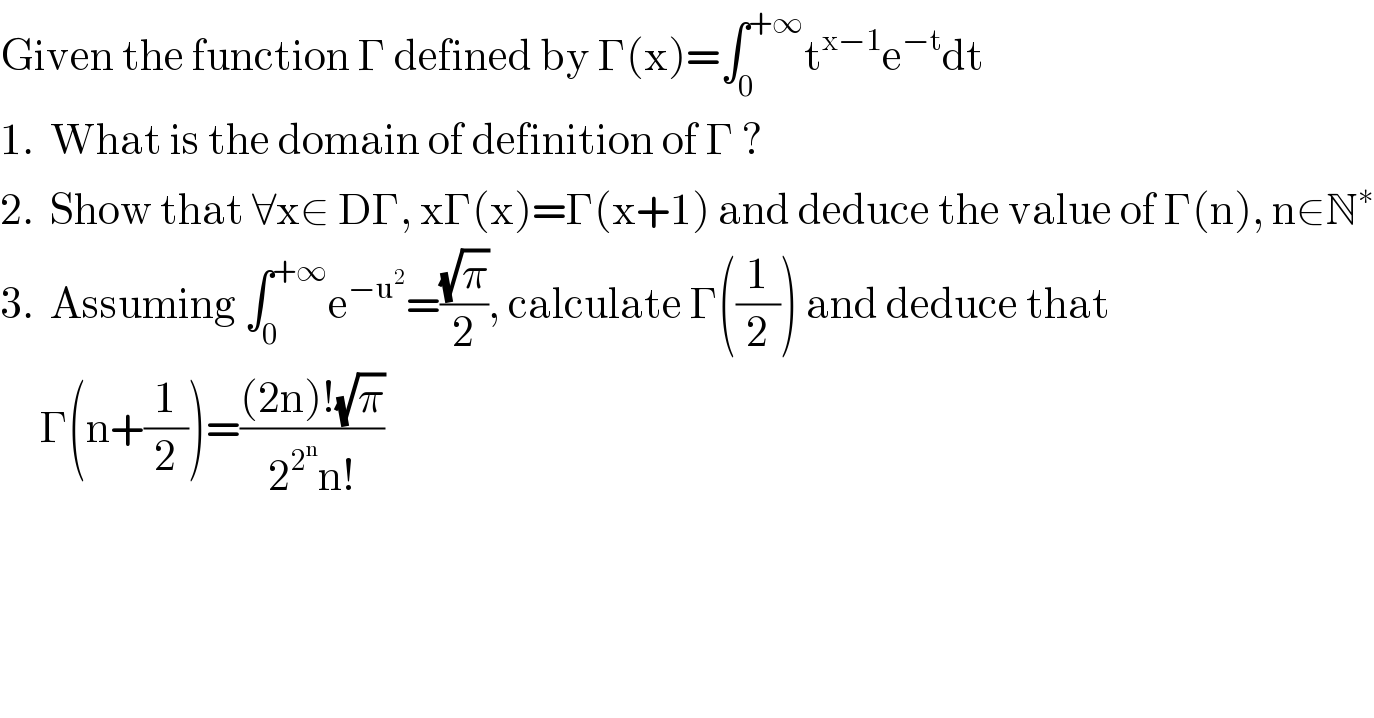
Question and Answers Forum
Question Number 108283 by Ar Brandon last updated on 16/Aug/20

Answered by mathmax by abdo last updated on 16/Aug/20
![1)Γ(x)=∫_0 ^∞ t^(x−1) e^(−t) dt =∫_0 ^1 t^(x−1) e^(−t) dt +∫_1 ^(+∞) t^(x−1) e^(−t) dt at v(0) t^(x−1) e^(−t) ∼t^(x−1) and ∫_0 ^1 t^(x−1) dt =∫_0 ^1 (dt/t^(1−x) ) conv ⇔1−x<1 ⇒x>0 at +∞ we have lim_(t→+∞) t^2 t^(x−1 ) e^(−t) =lim_(t→0) t^(x+1) e^(−t) =0 ⇒ ∫_1 ^∞ t^(x−1) e^(−t) dt converge for x>0 ⇒D_Γ =]0,+∞[ 2)Γ(x+1) =∫_0 ^∞ t^x e^(−t) dt =_(bypsrts) [−t^x e^(−t) ]_(t=0) ^∞ +∫_0 ^∞ xt^(x−1) e^(−t) dt =x ∫_0 ^∞ t^(x−1) e^(−t) dt =xΓ(x) ⇒for n natural Γ(n+1) =nΓ(n−1)=n(n−1)Γ(n−1)=...=n!Γ(1)=n! generaly Γ(x+n) =(x+n−1)(x+n−2)....(x+1)xΓ(x) 3)Γ((1/2)) =∫_0 ^∞ t^(−(1/2)) e^(−t) dt =∫_0 ^∞ (e^(−t) /(√t))dt =_((√t)=u) ∫_0 ^∞ (e^(−u^2 ) /u)(2u)du =2∫_0 ^∞ e^(−u^2 ) du =2.((√π)/2) =(√π) ⇒Γ((1/2))=(√π) 4) Γ((1/2)+n) =((1/2)+n−1)((1/2)+n−2).....((1/2)+1)(1/2)Γ((1/2)) =((2n−1)/2).((2n−3)/2) .......(3/2).(1/2)(√π) =((1.3.5.....(2n−3)(2n−1))/2^n )(√π) =((1.2.3.4.5.....(2n−1)(2n))/(2^n (2.4.6......(2n))))(√π) =(((2n)!)/(2^(2n) n!))(√π)](Q108301.png)
Commented by Ar Brandon last updated on 16/Aug/20
Thanks
| ||
Question and Answers Forum | ||
Question Number 108283 by Ar Brandon last updated on 16/Aug/20 | ||
 | ||
Answered by mathmax by abdo last updated on 16/Aug/20 | ||
![1)Γ(x)=∫_0 ^∞ t^(x−1) e^(−t) dt =∫_0 ^1 t^(x−1) e^(−t) dt +∫_1 ^(+∞) t^(x−1) e^(−t) dt at v(0) t^(x−1) e^(−t) ∼t^(x−1) and ∫_0 ^1 t^(x−1) dt =∫_0 ^1 (dt/t^(1−x) ) conv ⇔1−x<1 ⇒x>0 at +∞ we have lim_(t→+∞) t^2 t^(x−1 ) e^(−t) =lim_(t→0) t^(x+1) e^(−t) =0 ⇒ ∫_1 ^∞ t^(x−1) e^(−t) dt converge for x>0 ⇒D_Γ =]0,+∞[ 2)Γ(x+1) =∫_0 ^∞ t^x e^(−t) dt =_(bypsrts) [−t^x e^(−t) ]_(t=0) ^∞ +∫_0 ^∞ xt^(x−1) e^(−t) dt =x ∫_0 ^∞ t^(x−1) e^(−t) dt =xΓ(x) ⇒for n natural Γ(n+1) =nΓ(n−1)=n(n−1)Γ(n−1)=...=n!Γ(1)=n! generaly Γ(x+n) =(x+n−1)(x+n−2)....(x+1)xΓ(x) 3)Γ((1/2)) =∫_0 ^∞ t^(−(1/2)) e^(−t) dt =∫_0 ^∞ (e^(−t) /(√t))dt =_((√t)=u) ∫_0 ^∞ (e^(−u^2 ) /u)(2u)du =2∫_0 ^∞ e^(−u^2 ) du =2.((√π)/2) =(√π) ⇒Γ((1/2))=(√π) 4) Γ((1/2)+n) =((1/2)+n−1)((1/2)+n−2).....((1/2)+1)(1/2)Γ((1/2)) =((2n−1)/2).((2n−3)/2) .......(3/2).(1/2)(√π) =((1.3.5.....(2n−3)(2n−1))/2^n )(√π) =((1.2.3.4.5.....(2n−1)(2n))/(2^n (2.4.6......(2n))))(√π) =(((2n)!)/(2^(2n) n!))(√π)](Q108301.png) | ||
| ||
Commented by Ar Brandon last updated on 16/Aug/20 | ||
Thanks | ||